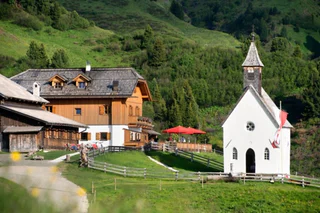
Church of St. Anne in Lana
Pavicolo/Pawigl, Lana, Meran/Merano and environs
South Tyrol's churches and monasteries offer a glimpse into the region's rich cultural and religious heritage. From ancient Romanesque structures to charming mountain sanctuaries, each site boasts exquisite architecture, intricate frescoes, and serene surroundings. Whether it's the awe-inspiring Brixen Cathedral or the picturesque Novacella Abbey, these sacred places invite visitors to marvel at their historical significance and find moments of tranquility amidst South Tyrol's breathtaking landscapes.

Pavicolo/Pawigl, Lana, Meran/Merano and environs

Rasun di Sopra/Oberrasen, Rasen-Antholz/Rasun Anterselva, Dolomites Region Kronplatz/Plan de Corones

Caerna/Garn, Feldthurns/Velturno, Brixen/Bressanone and environs

1/2
S.Cristina Gherdëina/S.Cristina Val Gardena/S.Cristina Gherdëina/St.Christina in Gröden, Kastelruth/Castelrotto, Dolomites Region Seiser Alm

Ponte Gardena/Waidbruck, Waidbruck/Ponte Gardena

Pietrarossa/Rotwand, Ritten/Renon, Bolzano/Bozen and environs

1/2
Nova Levante/Welschnofen, Welschnofen/Nova Levante, Dolomites Region Eggental

1/4
Fontanefredde/Kaltenbrunn, Truden/Trodena

1/3
Pinzano/Pinzon, Montan/Montagna, Alto Adige Wine Road

1/2
Ortisei/Urtijëi/St. Ulrich/Urtijëi, Urtijëi/Ortisei, Dolomites Region Val Gardena

Vallelunga/Langtaufers, Graun im Vinschgau/Curon Venosta, Vinschgau/Val Venosta

1/6
Moso in Passiria/Moos in Passeier, Moos in Passeier/Moso in Passiria, Meran/Merano and environs

1/2
Plars di Mezzo/Mitterplars, Algund/Lagundo, Meran/Merano and environs

1/2
Merano/Meran, Meran/Merano, Meran/Merano and environs

Anterselva di Mezzo/Antholz-Mittertal, Rasen-Antholz/Rasun Anterselva, Dolomites Region Kronplatz/Plan de Corones

1/2
Rio Lagundo/Aschbach, Algund/Lagundo, Meran/Merano and environs

1/6
Bressanone città/Brixen Stadt, Brixen/Bressanone, Brixen/Bressanone and environs

Villa Ottone/Uttenheim, Gais, Dolomites Region Kronplatz/Plan de Corones

1/3
Corvara/Corvara, Corvara, Dolomites Region Alta Badia

Rasun di Sopra/Oberrasen, Rasen-Antholz/Rasun Anterselva, Dolomites Region Kronplatz/Plan de Corones

1/5
Afing/Avigna, Jenesien/San Genesio Atesino, Bolzano/Bozen and environs

1/7
Villabassa/Niederdorf, Niederdorf/Villabassa, Dolomites Region 3 Zinnen

1/2
Dobbiaco Nuova/Neutoblach, Toblach/Dobbiaco, Dolomites Region 3 Zinnen

Terento/Terenten, Vintl/Vandoies, Brixen/Bressanone and environs

S. Martino/St. Martin - Casies/Gsies, Gsies/Valle di Casies

1/10
Pavicolo/Pawigl, Lana, Meran/Merano and environs

1/4
Trens/Trens, Freienfeld/Campo di Trens, Sterzing/Vipiteno and environs

1/4
Varna/Vahrn, Vahrn/Varna, Brixen/Bressanone and environs

Pavicolo/Pawigl, Lana, Meran/Merano and environs

1/4
Tramin an der Weinstraße/Termeno sulla Strada del Vino, Alto Adige Wine Road